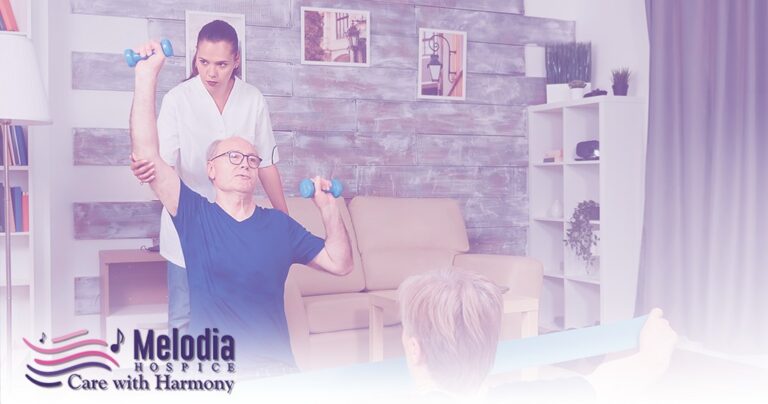Hospice Physical Therapy In San Francisco East Bay, California
Every year, life expectancy continues to rise but we still require maintenance and rehabilitation from time to time. Physical therapy for seniors is not a new concept but it had to evolve just as much as any other aspect of elder care. A home health aide or nurse is no longer capable of doing all tasks. Physical therapy has grown increasingly important in terms of overall health and well-being, especially with the availability of so many different treatment options to select from.
Think of physical therapy as an office with a lot of exercise equipment where athletes can go to recuperate from sports injuries. This is a common perception of the profession. However, while this is occasionally the case, a physical therapist works with a wide range of people (of all ages, interests, and injuries) and can perform their duties in a variety of settings, including hospitals, sports medicine centers and even in the comfort of your own home.
Circumstances for Home-Care Physical Therapy

You will most likely be required to come into their office or clinic for therapy unless you request a private, in-home appointment with the physical therapist first. The location where you receive therapy, on the other hand, is influenced by certain circumstances. As an example, if your health is critical and your mobility is restricted, you would not want to put yourself or others in danger by travelling to a medical appointment. If you do not have access to transportation, a therapist can come to you at a time that is convenient for you.
Why You Might Need Physical Therapy

A valuable resource, physical therapy supports patients in healing from trauma or post-surgery with exercises, stretches and massages as well as rehabilitative and practice sessions. Physical therapy may be required after knee or hip replacement surgery for seniors, particularly if they are transitioning from a cane or wheelchair to a walking frame. The use of physical therapy might assist you in relearning how to perform daily tasks if your mobility has been restricted.
Meeting With Your Physical Therapist

The first time you visit with a physical therapist, they will do a variety of tests to determine your level of strength and weakness in various areas. This will assist them in understanding what you need to do in order to increase your mobility and strengthen your muscles. Following your initial consultation, your physical therapist will assist you in developing a treatment plan that will identify the areas you need to focus on as well as a strategy for completing your care. Making this appointment at your house can make you feel more comfortable and confident than you would if you were in a clinic or hospital setting. It can also assist the therapist in determining whether or not you have any possible concerns in your home, such as stairwells.
Home Physical Therapy Treatments

When you have a fall, surgery or sickness, it can be difficult to recover on your own. It is even more difficult when you believe that you are unable to do things for yourself. Visits with a physical therapist can assist you in regaining your independence by having you perform exercises that will aid you in maintaining your balance, preventing falls, conserving energy and utilising adapted equipment and devices. House treatments take into consideration your environment and assist you in preparing for the best practices in your home, such as the optimal ways to lie, sit and move around your home.
Physical therapy, whether performed at your home or in a clinic, will aid in your recovery and restoration of strength. The fact that you are in your own home will help you comprehend how to put the exercises you have practiced into action while you are experiencing the confidence that comes from being in your own home. Physical therapy will also assist you in being more mobile and self-reliant as you progress.
Physical Therapies For Seniors

Suffocating is one of the most common causes of senior citizens losing their freedom. According to the National Center on Aging, more than one-third of all seniors over the age of 65 experience a fall each year, according to the Center. The services of a physical therapist can not only assist in the rehabilitation of those who have fallen, but they can also assist those who are still living independently and their loved ones in recognizing the signs and signals that someone may be losing their ability to walk and may require assistance or even prevention of future falls.
Utilizing Therapist Skills

It is possible that therapists from all disciplines are uniquely qualified to apply their problem-solving abilities to the construction of a safe environment for patients who are experiencing a medical crisis. It is possible that a speech therapist will be of assistance in the prevention of aspiration and the optimization of communication abilities, as examples of how the therapist can be beneficial. When it comes to dressing, bathing and self-care equipment, the occupational therapist may be the team member best qualified to recommend and provide instruction on adaptive equipment for the patient who wishes to maintain independence and limit dependency on caregivers for as long as possible.
It is a specialty field that comprises of a wide range of disciplines, which is known as occupational therapy. Beyond balance and postural concerns, the physical therapist may be educated about safety gear and even home modification issues to assist you in making your home patient-friendly.
There will be new obstacles and issues to deal with at various stages of the patient’s deterioration. This is quite normal. In order to assist them in dealing with these worries, therapy services should be sought by both the patient and their family. It will also help to lessen the amount of stress that is exerted on the entire caregiving team as a whole.
Improving Quality Of Life

Patients in hospice and palliative care may gain significant benefits from the seemingly small task of locating themselves in their surroundings. Positioning a patient’s chair, wheelchair or bed should be done in such a way that it allows for frequent adjustments. As a result, the occurrence of pressure ulcers and contractures can be considerably reduced. The attempts to change their position can benefit a large number of patients, as it can aid in pain reduction, swallowing, breathing, digestion and edema. It is unnecessarily damaging to one’s total quality of life if even one of these areas is neglected.
On the hospice and palliative care team, therapists can aid with a variety of tasks such as strengthening, balance and fall prevention, as well as transfer training. Patients and caregivers can benefit from their knowledge of the disease’s likely progression as well as the progression of their own mobility.
However, even while expert therapy services will never be the primary focus of care for a hospice or palliative care patient, having them in mind and making use of them when appropriate can be useful to the patient, their family and their caregivers. Everyone will benefit from the employment of therapists, as it will increase the overall safety of the environment while also ensuring that the maximum possible level of quality of life is maintained for as long as possible.
As a part of rehabilitative therapy practice, providing hospice and palliative care is a unique and rapidly developing subset of practice. The end of life is, by its very nature, a period of decline and this is something we recognize. When we apply our knowledge and abilities, we must be certain that we are satisfying the needs of each individual, as well as the needs of their families and caregivers.
Consider the essence of what we do in therapy: the vast majority of our care programs are palliative in nature rather than curative in nature, as the name implies. For daily tasks like as mobility, ADLs and communication, we seek to obtain the highest level of physical performance. Increasing the quality of life, guaranteeing safety and simplifying the transitioning period that happens near the end of life are all key goals.
No Pain Physical Therapy

Here’s where honesty comes into play; the reality is that we don’t want to watch our loved ones suffer any more than it is absolutely necessary. In order to keep those aches from becoming unbearable for our loved ones, we sometimes turn to pain medications. However, it is critical that we seek rehabilitation rather than just a fast cure or band-aid solution to the problem at hand. Physical therapy is required when there has been persistent pain in the last 90 days, when medicines have been provided for the pain (as a band-aid solution), when the pain is preventing someone from moving or when the pain is keeping them bedridden.
Melodia Care Home Health

We at Melodia Care Hospice want to make sure that you have as many options possible that fit into your schedule. With the use of functional exercises and activities, our Physical Therapists can assist you in regaining strength, endurance, pain management and overall quality of life in the comfort of your own home or the residence of your choice.
ou can reach us at any time of day or night by contacting us through our 24/7 online customer support chat or by calling 1-888 635-6347 (MELODI-7).
